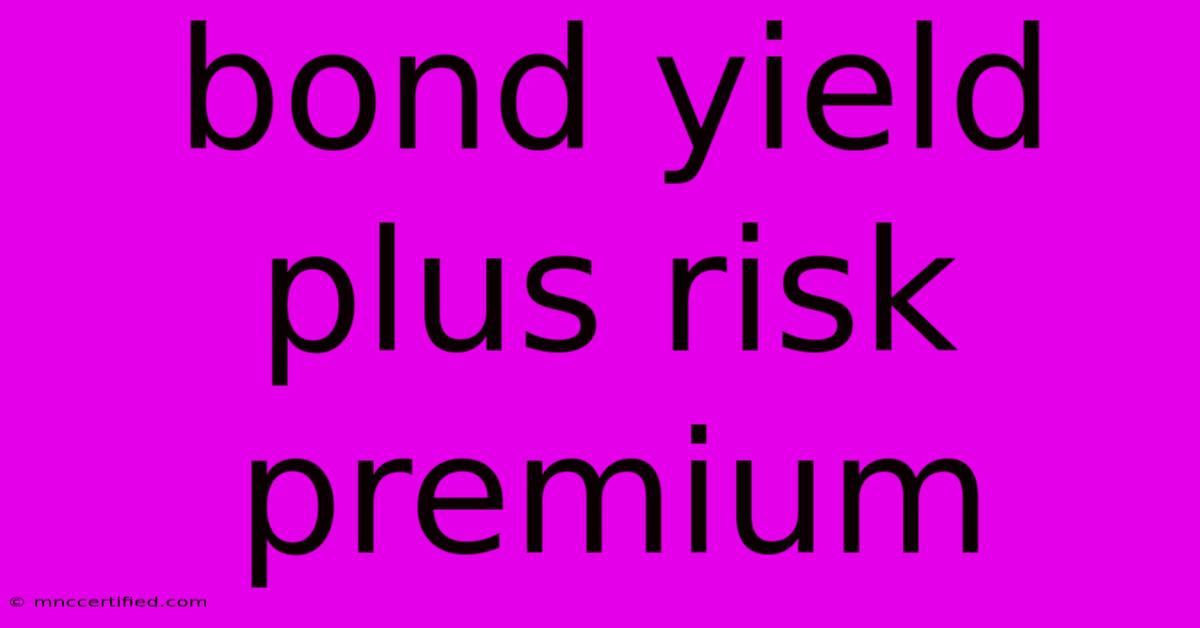Bond Yield Plus Risk Premium

Table of Contents
Bond Yield Plus Risk Premium: Understanding Total Return
Understanding the total return of a bond investment goes beyond simply looking at its yield. A crucial element is the risk premium, which compensates investors for the inherent risks associated with a specific bond. This article will delve into the concept of bond yield plus risk premium, explaining its components, calculation, and significance in investment decisions.
What is Bond Yield?
Before understanding the risk premium, we need a clear grasp of bond yield. The yield represents the return an investor receives from holding a bond until maturity. This is usually expressed as a percentage of the bond's face value (par value). There are several types of bond yields:
- Current Yield: This is the annual income (coupon payment) divided by the current market price of the bond. It reflects the return based on the current price, not the face value.
- Yield to Maturity (YTM): This is the total return anticipated if the bond is held until maturity, considering both coupon payments and the difference between the purchase price and face value. It accounts for the time value of money and is a more comprehensive measure than current yield.
- Yield to Call (YTC): This applies if the bond is callable (can be redeemed by the issuer before maturity). It considers the return if the bond is called at its call price.
Understanding the differences between these yields is crucial for accurate investment analysis. The choice of which yield to use depends on the specific investment horizon and the bond's features.
What is Risk Premium?
The risk premium is the extra return investors demand as compensation for taking on additional risk. This risk can stem from various factors:
- Credit Risk (Default Risk): The risk that the issuer will fail to make timely interest payments or repay the principal. Bonds issued by governments (like U.S. Treasuries) are generally considered lower risk than corporate bonds.
- Interest Rate Risk: The risk that changes in prevailing interest rates will affect the bond's price. Longer-term bonds are generally more sensitive to interest rate changes.
- Inflation Risk: The risk that inflation will erode the purchasing power of the bond's future cash flows.
- Liquidity Risk: The risk that the bond may be difficult to sell quickly without a significant price concession.
The higher the perceived risk, the higher the risk premium investors will demand. This is reflected in the bond's yield; higher-risk bonds generally offer higher yields.
Calculating Bond Yield Plus Risk Premium
There isn't a single, universally accepted formula for calculating the "bond yield plus risk premium." The approach depends on the specific risk assessment and the type of bond. However, the general concept is straightforward:
Total Return ≈ Risk-Free Rate + Risk Premium
Where:
- Total Return: The expected return from the bond (often approximated by YTM).
- Risk-Free Rate: The return on a virtually risk-free investment, such as a U.S. Treasury bond. This serves as a benchmark.
- Risk Premium: The additional return required to compensate for the bond's specific risks.
Determining the risk premium is often subjective and involves judgment. It can be estimated using various methods, including historical data, credit rating agencies' assessments, and quantitative models. Financial professionals often utilize sophisticated models considering multiple risk factors.
Significance in Investment Decisions
The concept of bond yield plus risk premium is essential for making informed investment decisions. By considering both the yield and the risk premium, investors can assess the potential return relative to the risk taken. A bond may offer a high yield, but if it carries a significantly high risk premium (reflecting substantial risk), its total return might not be attractive compared to a lower-yielding, lower-risk bond.
Investors should carefully analyze the risk profile of each bond and compare its total return potential to other available investment options. Diversification across various bond types with different risk profiles can help manage overall portfolio risk.
Conclusion
Understanding the bond yield plus risk premium is crucial for navigating the bond market effectively. While calculating the precise risk premium can be complex, understanding the underlying concepts and the factors influencing it empowers investors to make more informed decisions aligned with their risk tolerance and investment objectives. Remember to always consult with a financial advisor before making any significant investment decisions.

Thank you for visiting our website wich cover about Bond Yield Plus Risk Premium. We hope the information provided has been useful to you. Feel free to contact us if you have any questions or need further assistance. See you next time and dont miss to bookmark.
Featured Posts
-
Bonded Leather Couch Peeling
Nov 30, 2024
-
Haighs Resignation Phone Use Forces Transport Secretary Out
Nov 30, 2024
-
Glossier Brow Flick Versatile Pencil 30 Uses
Nov 30, 2024
-
Coronation Street Who Killed Les Battersby
Nov 30, 2024
-
Aladdin Bail Bonds Yuba City
Nov 30, 2024